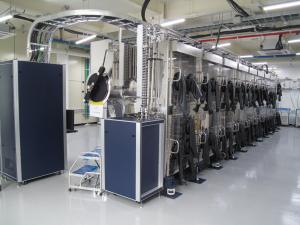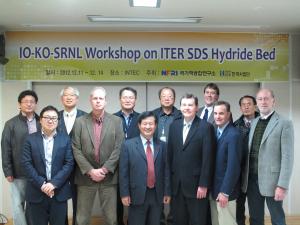Fully reversible storage for tritium
Recently, a meeting on the storage and delivery of tritium at ITER was held at the Korean Domestic Agency, with additional attendance of hydrogen experts from the Savannah River National Laboratory in the US.
The procurement of ITER's storage and delivery system is a Korean package. Tritium needs to be stored, provided for the fuelling of the machine on demand, and then stored again after removal from tokamak exhaust gases and recovery in the isotope separation system. And, of course, tritium must be safely handled at all times.
The Tritium Plant systems of ITER have to cope with tritium throughputs about two orders of magnitude higher than any other tritium facility operated before. Also, the tritium inventory for ITER will be two orders of magnitude higher than the inventories of JET or TFTR.
Tritium can be safely stored as metal hydride (tritide). At room temperature certain metals take up hydrogen isotopes like a sponge, forming a stable metal hydride. When heated to elevated temperatures, the metal hydride is decomposed, thus making it a fully reversible storage medium. Considering safety and performance requirements in ITER, the metal with the most suitable physico-chemical properties is (depleted) uranium. It acts like a very efficient and reversible absorption pump: at room temperature the tritium partial pressure above uranium tritide is equivalent to high vacuum, whilst at 420°C atmospheric pressure is reached, nine orders of magnitude higher than at room temperature.
A separate need to establish and maintain precise static and isothermal temperatures for tritium inventory measurements by calorimetry means that high levels of thermal isolation are also needed. This requirement will be met by locating the storage vessel for the hydride material within an outer jacket which can be gas-filled or under vacuum, depending upon the operations being performed by the getter bed.
The Korean Domestic Agency has made tremendous progress in the last years through a dedicated R&D program, building different small and full-scale getter beds to test their performance against the challenging ITER requirements. Now it is time to consolidate what was learned and come to final conclusions of getter bed design details, and direct the work towards a prototype bed. Already hydrogen and deuterium testing of the bed containing depleted uranium requires having the processing system inside of a glove box, similar to the ITER Tritium Plant where the glove box forms part of the tritium confinement system.
Patrick Camp, Technical Responsible Officer for the storage and delivery system at ITER commented on the Korean test facility (pictured): "We congratulate the tritium team at the Korean Domestic Agency for bringing together this complex and well-engineered test facility in such a short space of time. We look forward to seeing the results from the experiments in the near future."



